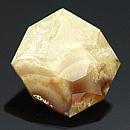|
|
||||||||||||||||
|
||||||||||||||||
|
||||||
|
|
|
|
Crandallite
|
|
| | |
| Discovered in 1917; IMA status: Valid (pre-IMA; Grandfathered) | ||
|
| ||
|
Chemistry |
|
|
| |
|
CaAl3(PO4)2(OH)5 · (H2O) | |
|
|
Hydrated Calcium Aluminum Phosphate Hydroxide |
|
Molecular Weight: |
414.02 gm |
|
Composition: |
Calcium |
9.68 % |
Ca |
13.54 % |
CaO |
|
|
Aluminum |
19.55 % |
Al |
36.94 % |
Al2O3 |
|
|
Phosphorus |
14.96 % |
P |
34.28 % |
P2O5 |
|
|
Hydrogen |
1.70 % |
H |
15.23 % |
H2O |
|
|
Oxygen |
54.10 % |
O |
|
|
|
|
|
100.00 % |
|
100.00 % |
= TOTAL OXIDE |
|
|
|
||||
|
Classification |
|
|
| |
|
Phosphates | |
|
7/B.36-10 | |
|
|
8 : PHOSPHATES, ARSENATES, VANADATES
|
|
Related to: |
Alunite Supergroup. Plumbogummite Group. Crandallite-Goyazite Series. The calcium analogue of Plumbogummite. The phosphate analogue of Arsenocrandallite. |
|
Members of Group: |
Plumbogummite Group: Benauite, Crandallite, Eylettersite, Florencite-(Ce), Florencite-(La), Florencite-(Nd), Florencite-(Sm), Galloplumbogummite, Gorceixite, Goyazite, Kintoreite, Kintoreite-2c, Plumbogummite, Springcreekite, Waylandite, Zaïrite |
|
Varieties: |
Strontian Crandallite |
|
Synonyms: |
Calcio-wavellite, Lehiite, Lime-wavellite, Pseudowavellite |
|
|
|
|
Crystal Data |
|
|
|
|
|
As trigonal prismatic crystals, terminated by {0001}, or as pseudocubic rhombohedra, to 1 mm; as rosettes of fibers or spherules and crusts with radial fibrous structure; commonly as colloform to pulverulent crusts, nodular, massive. |
|
|
None |
|
|
|
|
|
Physical Properties |
|
|
|
|
|
Perfect on {0001} |
|
|
Irregular/Uneven |
|
|
Brittle |
|
|
5.0 |
|
|
2.78 - 3.04 (g/cm3) |
|
|
None |
|
|
Not Radioactive |
|
|
|
|
|
Optical Properties |
|
|
|
|
|
Yellow, white, gray; colorless in thin section. Theoretically white; iron may make the mineral yellow to brown; also frequently stained when fine-grained. |
|
|
Translucent, Opaque |
|
|
Vitreous, dull to chalky when massive |
|
|
1.613 - 1.632 Uniaxial ( + ) |
|
|
0.009 - 0.011 |
|
|
n/a |
|
|
None |
|
|
|
|
|
Occurances |
|
|
|
|
|
Geological Setting: |
In weathered phosphatic aluminous sedimentary rocks and carbonatites. In phosphate-rich nodules; from complex granite pegmatites; in amphibolite-grade metaquartzites. An authigenic mineral in anoxic marine sediments or in clay-rich sediment beneath a tropical swamp. |
|
Common Associations: |
Albite, Brazilianite, Fluellite, Fluorapatite, Hydroxylherderite, Limonite, Magnesite, Microcline, Montebrasite, Quartz, Senegalite, Siderite, Topaz, Variscite, Wardite, Wavellite |
|
Common Impurities: |
Sr, Ba, Fe |
|
Type Locality: |
Brooklyn Mine, Silver City, Tintic District, East Tintic Mts, Juab Co., Utah, USA |
|
Year Discovered: |
1917 |
|
View mineral photos: | |
|
|
|
|
More Information |
|
|
|
|
|
| |
|
|
|
|
Crandallite was named in 1917 by Gerald F. Loughlin and Waldemar T. Schaller in honor of Milan Lucian Crandall, Jr. (1880 - 1959), mining engineer, Knight Mining Company, Provo, Utah, USA. Locations
for Crandallite: In the USA, in Utah, from the
Brooklyn mine, near Silver City, Tintic district, Juab
County, at the Little Green Monster mine, Clay Canyon,
about nine km west of Fairfield, and from Amatrice Hill,
about 40 km northwest of Fairfield, Utah County; in
the Palermo #1 and Fletcher mines, near North Groton,
Grafton County, New Hampshire; from near Gore, Frederick
County, Virginia; on Dug Hill, near Avant, Garland County,
Arkansas; in several rock formations in central and
northern Florida; from the Everly and Hugo mines, Pennington
County, and in the Tip Top mine, 8.5 km southwest of
Custer, Custer County, South Dakota. In the Alto Benedito
pegmatite, 15 km west of Picuí, Paraíba,
Brazil. At Blaton, Belgium. From Ronneburg, Thuringia,
Germany. In Wheal Jane, Kea, Cornwall, England. At Fort
Lismeenagh, Shenagolden, County Limerick, Ireland. From
the Kovdor massif, Kola Peninsula, Russia. In Australia,
in the Iron Monarch quarry, Iron Knob; the Moculta phosphate
quarry, northeast of Angaston; and at the Mt. Weld carbonatite,
35 km south of Laverton, South Australia. In the Buranga
pegmatite, near Gatumba, Rwanda. |
|
|
We
have not photographed our Crandallite
gems yet. Please
check back soon. |
